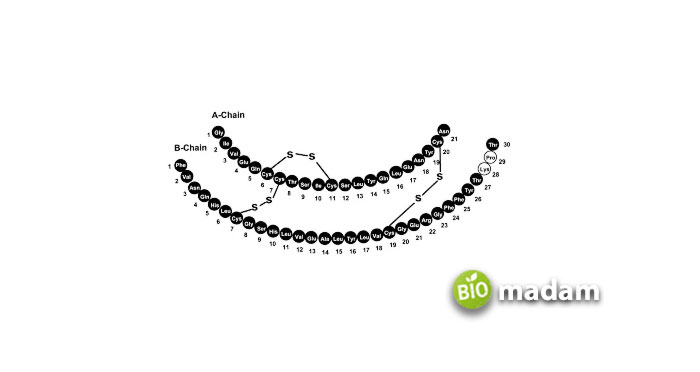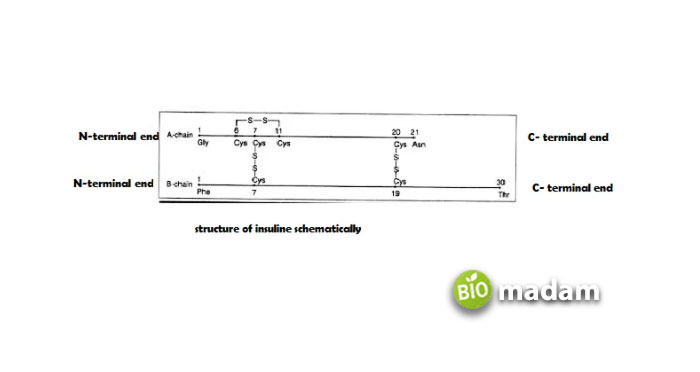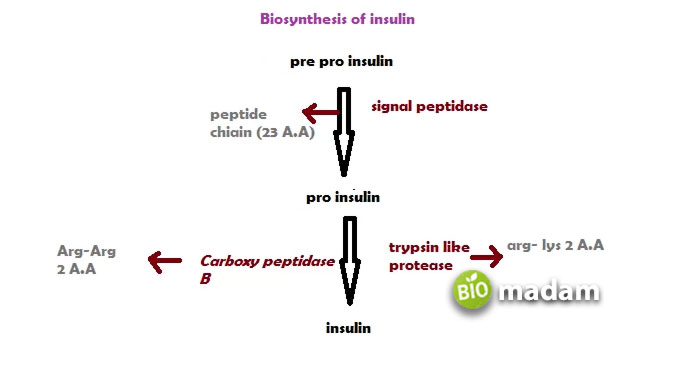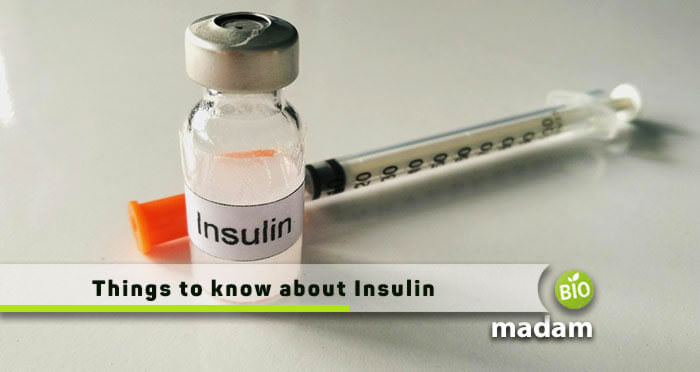Have you ever heard the term insulin? You must be familiar with one of the most prevalent diseases, diabetes? It is a natural hormone produced by the body that we will discuss in detail below. Let us tell you that most diabetic patients use this hormone synthetically to maintain their blood sugar level, which usually remains high.
Definition of Insulin
The B cells of islets of Langerhans secrete this protein hormone responsible for managing glucose levels in the body. It plays a very crucial role in metabolism as well. Insulin regulates the standard glucose mechanism and targets the muscle, liver, adipose, and heart tissues. Last but not least, insulin binds with receptor cells and attacks many tissues.
Is Insulin a Protein?
Insulin is a pure (globular) protein. Experts say that it is a peptide hormone having 51 amino acids with a molecular weight of 5808 Da. It is one of the two types of proteins; globular and fibrous.
Types of Insulin
Insulin is produced in several sub-types that all function to reduce glucose levels in your blood. When sugar is at its lowest level, the effect of insulin is said to have reached its peak. After this, the influence gradually wears off, and blood glucose levels rise.
Your family doctor or Credentialed Diabetes Educator will help you understand what type of insulin will be the best for you if you have diabetes.
Fast Acting Insulin
It is transparent in appearance and starts to work from 1 to 20 minutes. Fast-acting insulin peaks approximately 1 hour later and lasts from 3 to 5 hours. Eat immediately after injecting fast-acting insulin, or in an otherwise case, it will trouble you.
Short-Acting Insulin
Short-acting insulin is also clear in its appearance. It begins to work within half an hour, so you need to inject half an hour before eating, and it peaks at 2 to 4 hours and lasts for 6 to 8 hours.
Immediate-Acting Insulin
This type of insulin is cloudy in appearance and has either protamine or zinc added to delay its action. Immediate-acting insulin begins to work about one and a half hours after injecting, peaks at 4 to 12 hours, and lasts for 16 to 24 hours. Before injecting, check the leaflet included in the pack for instructions on preparing the insulin. It will help you avoid any mishap.
Mixed Insulin
Mixed insulin is also cloudy and contains pre-mixed combinations of fast-acting, short-acting insulin, or intermediate-acting insulin. It makes shooting easier by giving two types of insulin in one injection. This insulin can be taken before a meal to provide a stable hormone level, for some time, after the meal. Before injecting, check the leaflet included in the pack for instructions on preparing the insulin.
Long-Acting Insulin
This type of insulin has a cloudless appearance. It typically has no definite peak, but the onset of action usually lies within the first 1.5 hours. Most long-acting insulins last for up to 24 hours.
Insulin Diabetes

All the diabetic patients of either type use insulin due to disturbances in the natural production of insulin. There are generally two types of insulin diabetes, Type-1, and Type-2. Let’s look at them below:
Insulin Diabetes Type 1
In people with type 1 diabetes, the body produces little or no insulin. It is due to the B-cells producing insulin have been destroyed by an autoimmune reaction in the body. Doctors replace and treat this type of disease or condition by daily injecting insulin intramuscularly.
Insulin Diabetes Type 2
People with type 2 diabetes produce this hormone in a pretty minimal quantity that doesn’t perform the actual function. It is often referred to as insulin resistance. As for the compensation, the body even naturally tries to generate more insulin but eventually fails at balancing. If one changes his lifestyle, he can delay the need for tablets and maintain/stabilize his blood glucose level through proper diet and regular exercise. Still, if synthetic insulin is required, consider it a progression towards your good health.
Insulin Structure – Chemistry of Insulin
This protein is separated from the pancreas, and its crystals are formed. Insulin is typically referred to as a heterodimeric protein.

In A-chain, N-terminal is glycine, and C-terminal is asparagine. Similarly, in B-chain, N-terminal is phenylalanine, and C-terminal is threonine.
- Both chains link together with an S-S bond which is called a Disulfide Bridge. Cys-7 and Cys-20 of the A-chain connect with the Cys-7 and Cys-19 of the B-chain, as you can see from the diagram above.
- Similarly, Cys-6 and Cys-11 are joined together with the S-S bond in A-chain. If the disulfide bond breaks down with alkali or another reducing agent, insulin will go into its inactive state, thus reducing its function.
- An insulin’s structure exists in different polymeric forms, typically depending on the pH and temperature of the surrounding environment.
- Moreover, this molecule consists of two polypeptide chains, where one is called A-chain, and the other is termed B-chain. Fifty-one amino acids are present in its molecule, including 21 amino acids of the A-Chain and 30 amino acids of the B-chain.

Molecular Weight
- The molecular weight is 5808 Da
- If we physically measure an insulin molecule, its weight goes from about 12,000 to 48,000.
Biosynthesis of Insulin – Production of Insulin
Our body contains special cells called B-cells which are the islets of Langerhans in the pancreas. Insulin is naturally produced through this portion of a living body. This hormone presents in its premature form. This pre-insulin is further converted to proinsulin, which finally takes the shape of mature insulin. The insulin produced initially (pre-insulin) consists of 109 amino acids.
Synthesis of Preproinsulin
It is an inactive precursor of insulin that converts to proinsulin through a single peptidase enzyme.
Synthesis of Proinsulin
The preproinsulin moves to the lumen of the Rough Endoplasmic Reticulum, where it attaches to the ribosomes. It is then transported to the Golgi apparatus, from where it forms vesicles and secretes as proinsulin, a protein. This form of insulin has 86 Amino acids.
Synthesis of Insulin
Proinsulin containing small vesicles are detached from ER and fuses with the cisternae of the Golgi apparatus. Trypsin-like protease acts upon proinsulin and hydrolyses the peptide chain on both sides A and B. Here the active chains are formed, and the inactive C-peptide chain is liberated.
An enzyme carboxypeptidase B attacks the C-terminal peptide bond and cleaves it into two intermediates to release two C-terminal essential amino acids. These include liberating Arg-63 and Lys-62 from the A-chain, whereas, Arg-31 and Arg-32 from B-chain.

C-peptide has 31 amino acids that split off in the process. The two pairs of basic residues eliminate through carboxypeptidase after the cleavage of C-peptide. This peptide is the central portion of proinsulin, and the primary sequence of proinsulin goes in the order B-C-A. The resulting insulin is mature insulin which is further packaged in mature granules.
Functions of Insulin
- The chief and primary function of insulin is to control blood glucose levels. This hormone sends signals to fats, muscles, and liver cells that eventually take up glucose from the blood. The cycle keeps going until any defects occur and the body stops producing insulin.
- If a body has an adequate amount of energy, the hormone sends the signal to muscles to store glucose in the form of glycogen. Similarly, a liver also functions by storing glucose in the form of glycogen, but this quantity isn’t sufficient. The glycogen stored by the liver is just 5-6%.s
- Deficiency or inefficient working insulin will lead to hypoglycemia and hyperglycemia. If a body has a high glucose level, it means the person is struggling with diabetes, and a patient should control his glucose level in this case.
Side Effects of Insulin
The most common example of hypoglycemia is Glargine. Side effects are seen in patients using Lantus injection. Most doctors or experts prescribe this injection to patients with type-1 or type-2 diabetes. Prolonged hyperglycemia can severely damage human body organs and are lethal to health. Some common side effects of insulin are:
- Headache
- Weakness
- Sweeting
- Hunger
- Fast heartbeat
- Fainting
- Rapid breathing
- Irritation
- Body pain
Insulin Injection

Insulin should always be injected on the prescription of your doctor and as per the required dosage. Several diabetic patients have different insulin dosages. Insulin is intramuscularly injected in patients whose blood glucose level is not balanced with oral medicines.
Syringes Use
The syringe used to inject insulin should always be new and clean. The injection needle is recommended to be 12.8 mm in length. Still, there are different length sizes of syringes available in the market, so you should first consult your physician.
Where to Inject an Insulin?
There are different possible areas of the body where a patient has to inject insulin regularly. These can be:
Abdomen
One can inject insulin into the abdominal portion. This area is more prone to absorb the medication quickly.
Arm
An upper arm has more fats, so insulin can also be injected there.
Thigh
Another option to inject insulin is the human thighs. These areas are rich in muscle, so you can easily inoculate the dosage quantity there.
Final Verdict
So, insulin is basically a hormone to regulate blood sugar levels. For diabetic patients who are unable to produce sufficient insulin, synthetic insulin injections are a lifesaving treatment. While insulin has some potential side effects like hypoglycemia, overall it is a safe and effective therapy when used correctly under medical supervision.
Patients should follow their doctor’s advice on proper insulin injection techniques, dosages, and site rotations. With proper insulin therapy, people with diabetes can manage their condition and live full, healthy lives. Regular blood sugar monitoring and maintenance of a healthy diet and exercise routine are also key for balancing insulin needs.

Jeannie has achieved her Master’s degree in science and technology and is further pursuing a Ph.D. She desires to provide you the validated knowledge about science, technology, and the environment through writing articles.

